Trees Birds Mammals Fish Amphibians Reptiles
Wild Algarve
Bookshop
Neoboletus luridiformis (Rostk.) Gelardi, Simonini & Vizzini - Scarletina Bolete
Phylum: Basidiomycota - Class: Agaricomycetes - Order: Boletales - Family: Boletaceae
Distribution - Taxonomic History - Etymology - Identification - Culinary Notes - Reference Sources
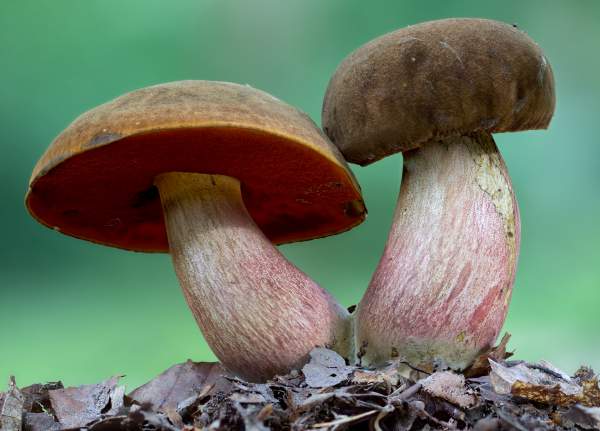
Neoboletus luridiformis is reported to be edible but could
be confused with poisonous species such as Rubroboletus satanas, the Devil's Bolete. When damaged the flesh of this chunky-stemmed mushroom turns blue very quickly.
Distribution
Fairly common in deciduous woodland and pine forests in Britain and Ireland, this attractive red-stemmed bolete is often found among bilberries. This bolete occurs also in many parts of North America, where it associates mainly with spruce.
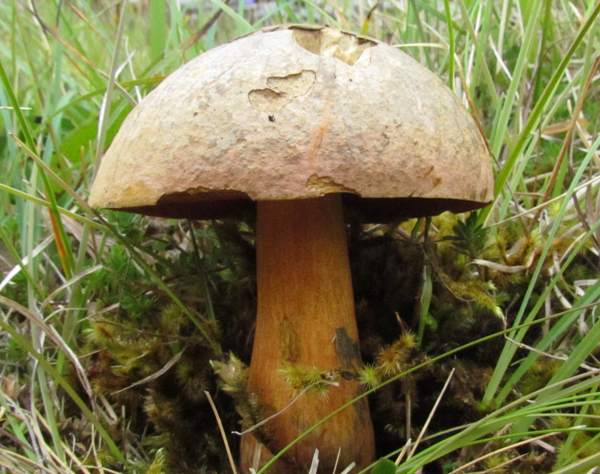
Taxonomic history
Neoboletus luridiformis was described in 1796 by Christiaan Hendrik Persoon, who gave it the name Boletus erythropus; however, the basionym dates from an 1844 publication by German mycologist Friedrich Wilhelm Gottlieb Theophil Rostkovius (1770 - 1848), who gave it the scientific name Boletus luridiformis.
Synonyms of Neoboletus luridiformis include Boletus luridiformis (Rostk.) and Boletus discolor (Quel.) Boud.
The autonomous form, var. luridiformis, has a darkish cap and a densely dotted ruddy stem. Another similar bolete previously known as Boletus luriformis var. discolor (Quel.) Krieglst., was described in 1991 by Lothar Gundolf Krieglsteiner (born 1965); it has a paler cap and a less ruddy yellowish stem that is only very lightly patterned with very fine red dots. This latter mushroom is mycorrhizal with oaks, and many authoroties now consider it to be just a colour form of Neoboletus luridiformis. (An example is shown above.)
Etymology
The generic name Boletus comes from the Greek bolos, meaning 'lump of clay', while the prefix neo- means new or young, and in taxonomy it is used to indicate a recent cladistic branch.
The specific epithet luridiformis suggests that this species is similar in form to Suillellus luridus.
Identification guide
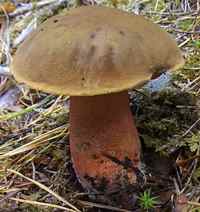
|
Cap
The cap colour of this often massive bolete is very
variable. It can be dark chocolate brown, pale brown or even, as in this
fine specimen, coppery bronze. The cap flesh is yellow, rapidly bluing
when cut or bruised.
Caps of Neoboletus luridiformis are initially downy and convex, becoming flatter, smooth and shiny
as the fruitbody matures. The diameter at maturity varies between 8
and 20cm.
|
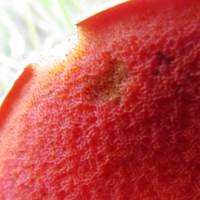 |
Tubes and Pores
Orange at first, the round, crowded pores soon
become bright red and then rusty brown with age.
The spore tubes are lemon yellow, but they very quickly turn blue-green
when cut or bruised. |
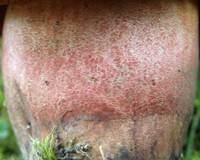
|
Stem
Apart from a pale area near the apex, a pattern of tiny red dots covers most
of the stem of Neoboletus luridiformis. (A hand lens may be necessary to distinguish
the separate dots on some specimens.)
Typically 2 to 4cm in diameter and more or less parallel sided, stems
of the Scarletina Bolete range between 7 and 15cm tall and have yellow flesh that instantly turns
blue-green when cut or bruised. |
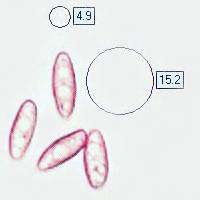 |
Spores
Sub-fusiform (broadly spindle-shaped) to broadly ellipsoidal, 12-16 x 4.5-6µm.
Spore print
Olive-brown. |
Odour/taste |
Not distinctive. |
Habitat & Ecological role |
On acid soils under conifers, particularly spruces, and under beeches; and (var. discolor) occasionally
oaks, most often at the edge of a wood or a clearing. The Scarletina Bolete is known to form ectomycorrhizal associations with both spruce (Picea spp.) and beech (Fagus spp.) and (for var. discolor) with oaks. |
Season |
August to October in Britain and Ireland. |
Similar species |
Suillellus luridus is similar but has a red net pattern on its stem.
Suillellus satanas has a chalky white cap and a bulbous stem covered in a bright red net pattern on a yellow background; it is
poisonous. |
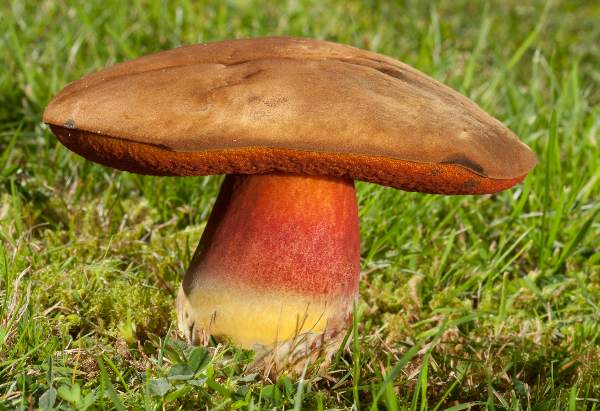
Culinary Notes
Neoboletus luridiformis, the Scarletina Bolete, is reported to be edible, but this mushroom is easily
confused with poisonous species such as Rubroboletus satanas, the Devil's Bolete. (I have been informed that Satan's Bolete turns black when cooked, and the appearance of such a meal may be off putting to some people; however, I have heard from someone with first-hand experience that the Scarletina Bolete rapidly reverts to a tan colour when heated in the pan.) We cannot offer definitive advice on the edibility of any fungi or plant specimens, especially based on pictures alone, as the risk of misidentification is too great. Our advice is: if in doubt, leave it out.
Reference Sources
Fascinated by Fungi, 2nd Edition, Pat O'Reilly 2016, reprinted by Coch-y-bonddu Books in 2022.
BMS English Names for Fungi
Roy Watling & Hills, A.E. 2005. Boletes and their allies (revised and enlarged edition), - in: Henderson, D.M., Orton, P.D. & Watling, R. [eds]. British Fungus Flora. Agarics and boleti. Vol. 1. Royal Botanic Garden, Edinburgh.
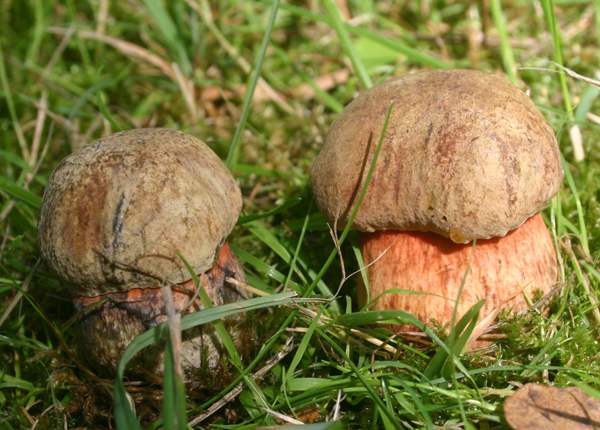
British Boletes, with keys to species, Geoffrey Kibby (self published) 3rd Edition 2012
Dictionary of the Fungi; Paul M. Kirk, Paul F. Cannon, David W. Minter and J. A. Stalpers; CABI, 2008
Taxonomic history and synonym information on these pages is drawn from many sources but in particular from the British Mycological Society's GB Checklist of Fungi.
Watling, R. 2004. New combinations in Boletaceae and Gomphidiaceae (Boletales). – Edinburgh Journal of Botany 61: 41–47.
Knudsen, H. & Vesterholt, J. [eds.]. 2008. Funga Nordica. Nordsvamp, Kopenhagen.
BMS English Names for Fungi
Acknowledgements
This page includes pictures kindly contributed by David Kelly.
Top of page...
Fascinated by Fungi. Back by popular demand, Pat O'Reilly's best-selling 450-page hardback book is available now. The latest second edition was republished with a sparkling new cover design in September 2022 by Coch-y-Bonddu Books. Full details and copies are available from the publisher's online bookshop...